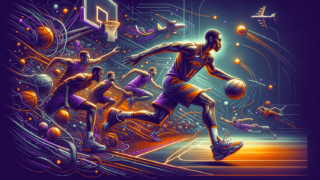
Welcome to the exciting world of basketball, where strategic moves and fast-paced action keep fans and players hooked day after day! If you’re ready to dive into the nitty-gritty details of the game, you’ve come to the right place. In this blog post, we’ll explore the fascinating art of a fade screen in basketball, unveiling its essentials and nuances to arm you with knowledge that’ll enrich your understanding of the game. Get ready for a thrilling journey into the depths of this often-overlooked yet highly effective maneuver!
What’s a Fade Screen in Basketball?
A fade screen in basketball is an offensive maneuver where a player, typically a guard or a wing, sets a screen for a teammate away from the ball-handler, and then pivots or “fades” to an open area on the court. This action creates separation from the defender, allowing the screener to receive a pass and potentially get an open shot or drive to the basket. It’s an excellent way to exploit the defensive focus on the primary ball-handler and generate scoring opportunities for other players on the court.
Understanding the Fundamentals of a Fade Screen
Before we delve into the diverse aspects of a fade screen, it’s crucial to lay the foundation with some fundamental basketball concepts. In basketball, screens, also known as picks, are versatile maneuvers that help create space for ball-handlers and shooters while disrupting the opposing team’s defense. A fade screen is a specific type of off-ball screen that enables teammates to capitalize on defensive weaknesses and contribute to the success of the offense.
Setting Up the Fade Screen
While the fade screen may appear relatively straightforward, its effectiveness depends on the precise timing and positioning of the players involved. Here’s the basic setup:
- The player setting the screen, usually the screener or picker, positions themselves between their teammate and the defending player. It’s essential to maintain an athletic stance and keep feet shoulder-width apart for maximum impact.
- The offensive player using the screen, typically the cutter or shooter, approaches the screen and uses it to maneuver around their defender. They must maintain minimal contact with the screener for maximum efficiency and stay close to the pick to impede the defender’s path.
- Once the cutter has cleared the screen, the screener “fades” or pivots away from the original position towards an open area on the court. This movement is the critical element of the fade screen technique. Ideally, this change in direction should confuse the defenders and create an open shot opportunity.
Executing the Fade Screen to Perfection
With the basic principles established, let’s examine the essential steps to excel in executing the fade screen:
Mastering the Art of Communication
As with most team sports, communication is an indispensable element in executing plays successfully. Forms of communication include verbal calls, hand signals, or eye contact between teammates. This form of communication helps ensure the right teammate knows when to set a screen and when to initiate the fade. The earlier the screener announces their intention and positions themselves, the better it is for everyone, minimizing the chances of offensive fouls.
Timing is Everything
As the screener, determining the perfect moment to set, initiate, and release the screen is crucial. Too soon, and the defender may catch on, preventing an open shot or cut. Too late, and the intended path might close, jeopardizing the play. The key to nailing perfect timing stems from thorough awareness of your teammates’ positioning and an understanding of their game plan.
Reading the Defense
In addition to communication and timing, another aspect vital to a well-executed fade screen is the ability to read the opposing defense. To exploit defensive weak points and further enhance the screen’s effectiveness, the offensive player using the screen must anticipate how their defender will react to the play. Recognizing whether the defender will go over or under the screen, switch, or hedge enables the offensive player to adjust their route accordingly.
Tailoring the Fade Screen to Different Scenarios
Fade screens are adaptable to various game situations, making them an essential part of any basketball playbook. By understanding different scenarios and adjusting accordingly, players can derive maximum value from this versatile maneuver.
Utilizing the Fade Screen in Baseline Out-of-Bounds Plays
Baseline out-of-bounds plays often involve intricate off-ball movements to create open shots. A well-timed fade screen could provide the necessary space for a teammate to slip into a comfortable shooting position before defenders reach them. By fading to the perimeter, the screener can catch a quick pass and launch a shot before the defense recovers.
Capitalizing on Mismatches in the Post Area
A classic fade screen can take advantage of mismatch situations near the hoop. When a smaller defender switches onto a larger offensive player in the post, the offense can exploit this height difference by establishing a deep position and completing a high-percentage shot. In such a case, the screener can fade into the post area to receive a pass and use size and strength to gain an advantage.
Creating Open Shots in Half-Court Sets
When an offense is running a half-court set, it faces the challenge of breaking down a more organized defense. A well-executed fade screen can force defenders to chase or be caught in compromising positions. This maneuver can create open shot opportunities both at the perimeter and near the basket. By analyzing team tactics and opponents’ tendencies, players can leverage the fade screen to outsmart competitors and establish high-quality shot and drive possibilities.
Mastering the Fade Screen’s Defensive Countermeasures
As alluring as the fade screen’s benefits are, it’s crucial to acknowledge the opposing team’s attempts to foil the play. Here are some defensive countermeasures to the fade screen and some tips on overcoming them:
Fighting Through the Screen
A determined defender may choose to fight through the screen, staying as close to the offensive player as possible without fouling. To overcome this aggressive defense, the screener must set a solid pick and hold position before initiating the fade. Meanwhile, the cutter must stay close, creating separation by utilizing their body and quickness.
Switching Defenders
Another common tactic to neutralize a fade screen is by having defenders switch assignments. In anticipation of this, the offensive players can tailor their maneuvers to exploit any mismatch created, adjust screening angles, or opt for a “slip” instead of a fade, wherein the screener quickly moves towards the basket before full contact with the defender.
Hedging the Screen
When a defender momentarily steps out to impede the progress of the offensive player using the screen, it is known as hedging. In such cases, it’s crucial for the screener to set a solid pick and fade quickly, requiring both the cutter and screener to make sharp, well-timed movements to evade this defensive strategy.
Drills and Tips to Enhance Your Fade Screen Skills
Now, more than ever, it’s evident that the fade screen is a potent weapon in any basketball arsenal. Here are some useful drills and tips to help you and your teammates elevate your game:
Three-Player Fade Screen Drill
This drill simulates game-like situations that help improve communication, timing, and execution of the fade screen. Involving a ball-handler, screener, and cutter, the setup aims to improve players’ screen-setting and off-the-ball movements, as well as their ability to read the defense and make decisions.
Two-Ball Fade Screen Shooting Drill
This drill adds a shooting component to the basics of the fade screen, enhancing players’ capacity to receive a pass and quickly execute a shot. It also enhances communication, sharpens decision-making, and aids in reading the defender’s position.
Watch and Learn from the Best
One of the most effective ways to improve fade screen technique is by studying professional basketball games. Observe how premier players set screens, communicate with their teammates, and exploit fading opportunities to create open shots.
With diligent practice, sharp analysis, and a team-oriented approach, you’ll start to see the fade screen emerge as a prominent feature of your basketball repertoire. So, hit the hardwood armed with newfound knowledge and expertise and watch your team’s offense unlock its full potential with the compelling art of a fade screen in basketball.
Fade Screen Variations and Strategies
Basketball never stops evolving, and so do its tactics and maneuvers, including the fade screen. Exploring various fade screen modifications and additional complementary strategies will help enrich your understanding and enhance your in-game execution.
The Flare Screen
A close relative to the fade screen is the flare screen, wherein the screener moves towards the offensive player using the screen, rather than moving directly towards the defender. This subtle difference changes the screen’s angle and allows the player using the screen to drift away from the basket, creating an open shot opportunity from the three-point line or the wing.
Stacked Screens
One way to amplify the fade screen’s effectiveness is through the use of stacked screens. This strategical maneuver involves multiple teammates setting aligned screens for each other in quick succession. Stacked screens are more challenging for the opposing defense to navigate, increasing the likelihood of creating separation and generating open shot opportunities.
Utilizing Misdirection
To further maximize the fade screen’s potential, players can employ misdirection tactics to keep defenders guessing. For example, a screener may fake a screen on one side before quickly setting up on the opposite side. These sudden movements can catch the defense off-guard, creating confusion and generating the space needed for scoring opportunities.
Common Mistakes to Avoid When Executing Fade Screens
Even the best-intentioned offensive maneuvers can sometimes fall short due to errors or miscommunication on the court. To make the most of your fade screen knowledge, familiarize yourself with common mistakes to avoid:
Illegal Screens or Moving Screens
Screener must establish a stationary position before the opponent makes contact. Failure to do so will result in a moving screen violation, forfeiting possession to the opposing team. To avoid this, ensure that you plant your feet shoulder-width apart and maintain balance before the defender engages with the screen.
Telegraphing the Screen
While communication is crucial for executing a fade screen effectively, excessive signaling can alert the opposing defenders and make the play more predictable. Refine your non-verbal communication, such as eye contact or subtle hand signals, to maintain the element of surprise and maximize the fade screen’s potential.
Rushing the Fade
To execute the fade screen effectively, proper timing is essential. Rushing the fade or failing to establish a solid pick may result in poor spacing and dysfunctional offensive play. Patience, focused communication, and synchronization with teammates are necessary skills for successfully executing the fade screen.
Developing a Basketball IQ That Enhances Your Fade Screen Game
While physical skills and techniques are vital in basketball, the importance of a high basketball IQ should not be underestimated. Cultivating an innate understanding of the sport, team dynamics, and individual matchups will elevate the impact of your fade screens, even if the baseline execution remains unchanged.
Scouting Opponents and Identifying their Defensive Tendencies
One crucial aspect of developing a high basketball IQ is understanding the defensive tendencies of your opponents. By studying their strategies and preferences, you can exploit these patterns to enhance the potency of your fade screens, creating new scoring opportunities and boosting your team’s chances of success.
Adapting to Changing Game Situations
As the game unfolds, teams make adjustments to counteract their opponents’ strengths and exploit their weaknesses. Continued analysis of evolving game situations, coupled with the ability to adapt your fade screen tactics accordingly, will enhance your on-court impact and contribute more consistently to your team’s success.
Ultimately, a comprehensive appreciation of the fade screen couples physical execution with the development of a high basketball IQ. By committing to individual and team improvement in these key areas, you can enhance your fade screen game and contribute to your team’s triumphs on the hardwood.
Frequently Asked Questions (FAQ)
Still have questions about the fade screen in basketball? Let’s address some of the most common questions and provide concise, informative answers to enhance your understanding of this valuable basketball maneuver.
1. What’s the primary difference between a fade screen and a traditional screen?
The key difference between a traditional (on-ball) screen and a fade screen is that the fade screen is an off-ball maneuver. In a fade screen, the screener sets a pick away from the ball-handler and then pivots or “fades” to an open area, creating separation from the defender.
2. Can any position on the court execute a fade screen?
Yes, any player on the court can execute a fade screen. However, it’s most commonly utilized by guards and wings due to their agility and shooting abilities.
3. How can the defense best counter a fade screen?
Defenders can fight through the screen, switch assignments, or hedge out to disrupt the fade screen. The appropriate defensive action depends on the specific game situation and individual matchups.
4. What is a flare screen?
A flare screen is a variation of the fade screen, where the screener moves towards the player using the screen, creating a different angle for the offensive player to drift away from the basket and establish an open shot.
5. When should I use a slip screen instead of a fade screen?
A slip screen is used when the defenders switch assignments or show a strong hedge. In this situation, the screener quickly moves towards the basket before making complete contact with the defender, exploiting the temporary defensive confusion.
6. Are moving screens illegal in basketball?
Yes, moving screens are illegal. A screener must establish a stationary position before contact with the defender, or they risk being called for an offensive foul.
7. How can I improve my fade screen execution?
To improve your fade screen execution, focus on refining communication, perfecting timing, reading the defense, and practicing drills that simulate game-like situations.
8. How do professionals use the fade screen effectively?
Professionals use the fade screen effectively by studying their opponents, anticipating defensive adjustments, and employing misdirection tactics to catch defenders off-guard and create open shot opportunities.
9. Can the fade screen be used in out-of-bounds plays?
Yes, a well-timed fade screen can be effectively used in baseline out-of-bounds plays to create open shots for teammates.
10. What are the benefits of a fade screen?
The fade screen benefits teams by exploiting defensive weaknesses, creating open shot opportunities, and generating space for drives and other offensive plays.
11. What is a stacked screen?
A stacked screen is a strategical maneuver wherein multiple teammates set aligned screens for each other in quick succession, making it more challenging for defenders to navigate and creating better scoring opportunities.
12. How can I improve my basketball IQ to elevate my fade screen game?
Develop your basketball IQ by scouting opponents, analyzing defensive tendencies, watching professional games, and adapting to changing game situations.
13. What are some common mistakes to avoid when executing fade screens?
Some common mistakes include setting illegal or moving screens, telegraphing the screen, and rushing the fade. To avoid these errors, be patient, maintain proper form and positioning, and communicate effectively with your teammates.
Featured Posts
- No pillar pages found.





